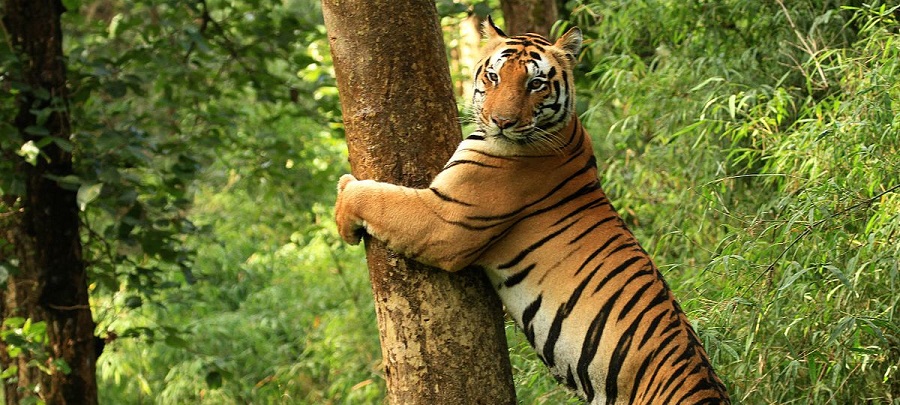Valmiki Tiger Reserve: A Sanctuary of Wildlife Heritage

Valmiki Tiger Reserve is a magnificent sanctuary that showcases India's rich wildlife heritage. Located in the West Champaran district of Bihar, this reserve is not just a haven for tigers but a vital ecosystem teeming with diverse flora and fauna. Covering an area of approximately 899 square kilometers, Valmiki Tiger Reserve is the only tiger reserve in Bihar, playing a crucial role in the conservation of the Bengal tiger and numerous other species.
Historical Significance
The Valmiki Tiger Reserve derives its name from the ancient sage Valmiki, the author of the epic Ramayana. The region is steeped in mythological significance, with several sites within the reserve linked to the legend of Lord Rama and sage Valmiki. This historical and cultural heritage adds a unique dimension to the reserve, blending nature and mythology in a captivating narrative.
Geographical Diversity
The geographical diversity of Valmiki Tiger Reserve is one of its most striking features. It lies along the Indo-Nepal border, flanked by the Shivalik range and the river Gandak, which creates a mosaic of landscapes ranging from dense forests and grasslands to riverine ecosystems. This varied terrain supports a wide range of habitats, making it an ecological treasure trove.
The reserve is part of the larger Terai Arc Landscape, which stretches across India and Nepal, serving as a critical corridor for wildlife movement. This connectivity is essential for the genetic diversity and survival of several species, particularly large mammals like tigers and elephants.
Flora and Fauna
Valmiki Tiger Reserve is a botanist’s paradise with its diverse range of vegetation. The forest types include sal, dry deciduous, moist deciduous, and riverine forests, along with extensive grasslands. This variety in vegetation provides the necessary habitat for a rich array of wildlife.
Mammals - The Bengal tiger is the flagship species of the reserve, with the park providing a crucial habitat for this endangered predator. Leopards, Indian bison (gaur), wild boar, sambar deer, chital (spotted deer), and barking deer are among the other notable mammals. The reserve is also home to several primates, including the rhesus macaque and the Hanuman langur.
Birds - Birdwatchers find Valmiki Tiger Reserve a paradise, with over 250 species recorded. The vibrant birdlife includes the great hornbill, crested serpent eagle, Indian pied hornbill, and various species of owls and woodpeckers. The wetlands within the reserve attract numerous migratory birds, adding to the avian diversity.
Reptiles and Amphibians - The reserve’s rivers and wetlands are habitats for several reptile species, including the mugger crocodile, gharial, and various turtles. Frogs, toads, and other amphibians are also abundant, contributing to the ecological richness of the area.
Valmiki Forest Preservation Efforts
Preservation efforts at Valmiki Tiger Reserve are multifaceted, focusing on habitat preservation, anti-poaching measures, and community involvement. The park authorities have implemented several programs to protect the tiger population and other wildlife. Anti-poaching patrols, habitat restoration projects, and monitoring of wildlife populations are crucial components of these efforts.
One of the significant challenges faced by the reserve is human-wildlife conflict, primarily due to the proximity of human settlements. Initiatives to create awareness and involve local communities in protection activities have been essential in mitigating these conflicts. Eco-development programs aim to provide alternative livelihoods to reduce dependency on forest resources.
Ecotourism and Community Engagement
Valmiki Tiger Reserve has immense potential for ecotourism, offering a blend of wildlife experiences and cultural heritage. Jungle safaris, bird watching, and nature walks allow visitors to immerse themselves in the natural beauty of the reserve. The scenic landscapes, coupled with the chance to spot tigers and other wildlife, attract nature enthusiasts and photographers alike.
Educational programs and nature camps are organized to raise awareness about the importance of conservation. These initiatives help foster a sense of responsibility towards the environment among visitors, especially the younger generation. Engaging local communities in tourism activities not only generates revenue but also encourages them to participate actively in conservation efforts.
Conclusion
Valmiki Tiger Reserve stands as a testament to India’s commitment to preserving its wildlife heritage. The rich biodiversity, coupled with ongoing conservation efforts and community involvement, makes it a beacon of hope in the fight to protect our natural ecosystems. As we continue to face global environmental challenges, the story of Valmiki Tiger Reserve serves as a powerful reminder of the importance of preserving our natural heritage for future generations.